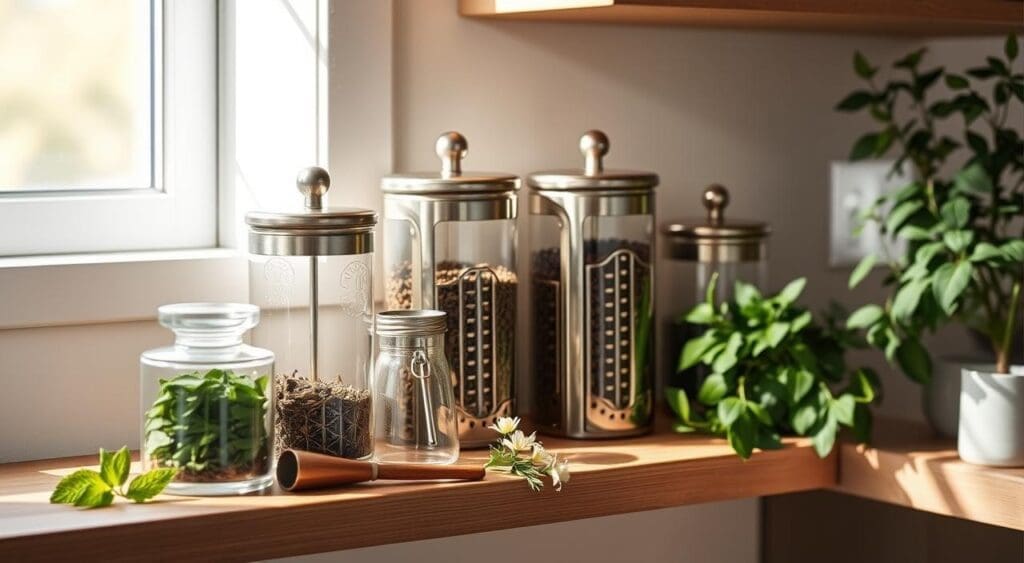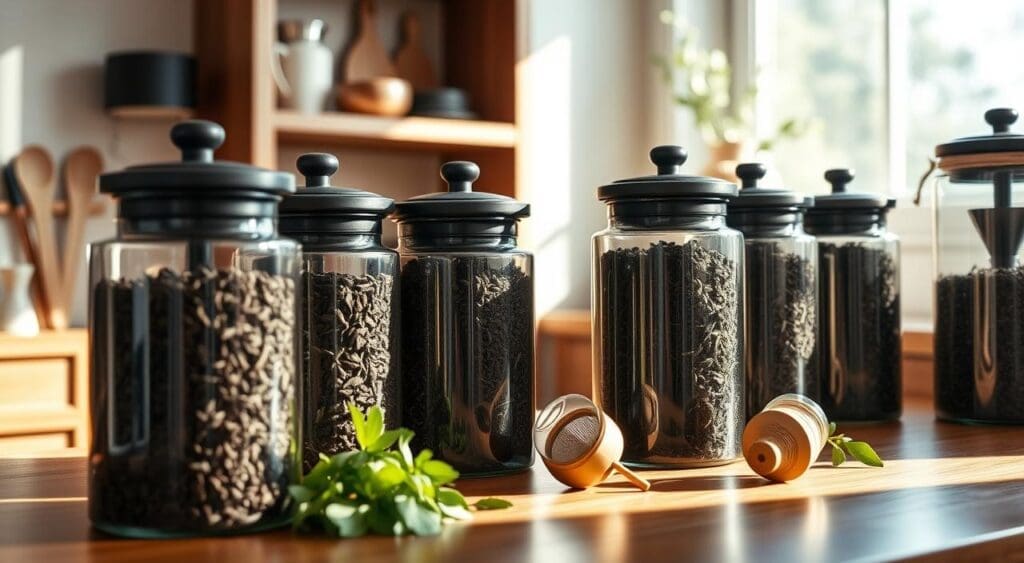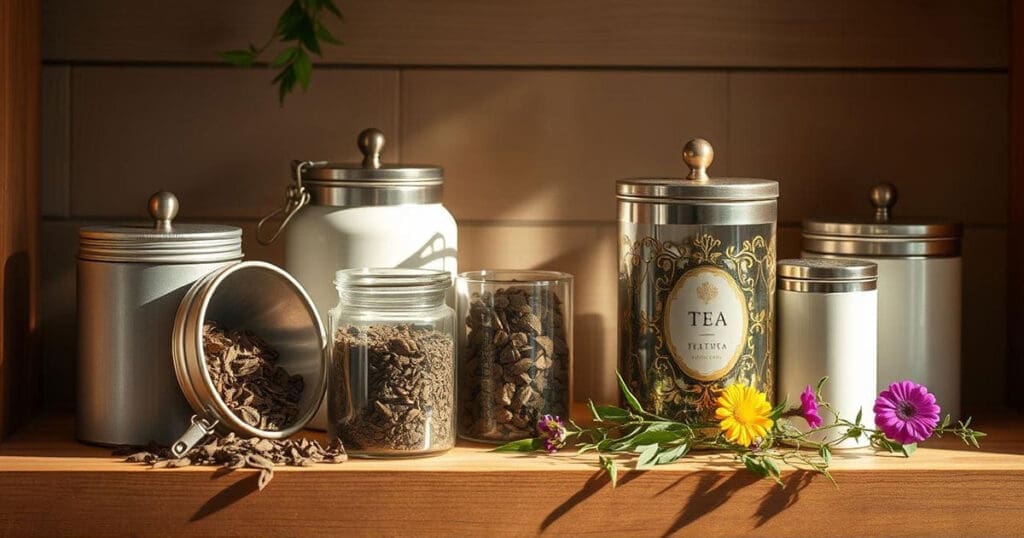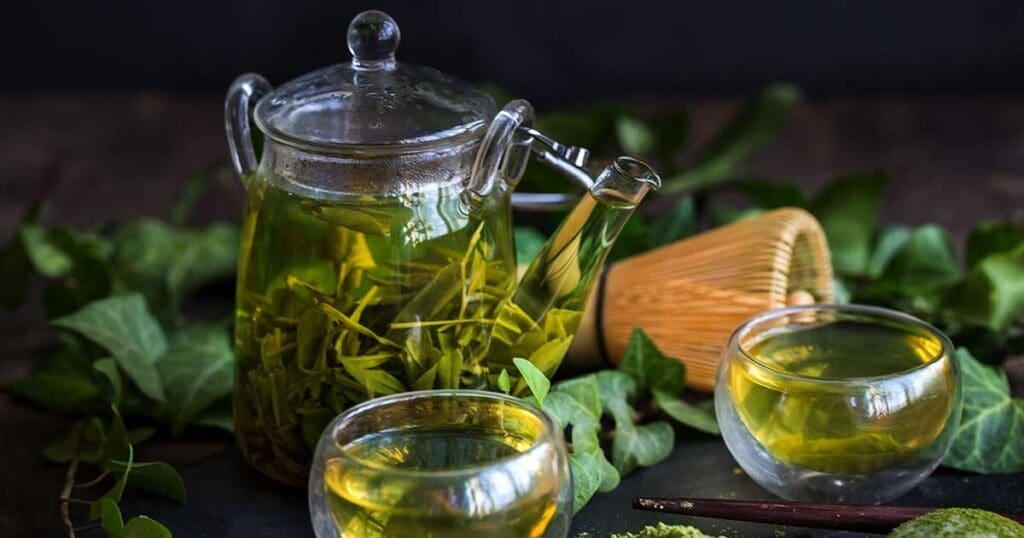We know how important it is to keep tea tasting great. That's why we're excited to share our tips on storing tea. Proper storage is key to keeping tea's flavor and aroma just right.
Storing tea can be tricky, but with the right methods, you can keep it tasting amazing. In this guide, we'll cover the basics of tea storage. We'll give you the knowledge to keep your tea fresh and tasty.
We aim to help you understand how to keep tea fresh. Whether you're a seasoned tea lover or new to tea, our guide has you covered. You'll learn how to store your tea with confidence.
Introduction to Tea Storage
Storing tea is an art that needs attention and knowledge. By following our guide, you'll learn how to store your tea for maximum freshness. Enjoy the perfect cup every time.
Key Takeaways
- Proper tea storage is essential for maintaining the flavor and quality of tea
- Tea storage tips can help you keep your tea fresh and delicious
- Understanding the factors that affect tea quality is crucial for storing tea
- Our guide will provide you with the knowledge you need to store your tea with confidence
- Storing tea requires attention to detail and a bit of knowledge about tea storage
- By following our guide, you'll learn how to store your tea for maximum freshness
Understanding Why Proper Tea Storage Matters
Enjoying the perfect cup of tea starts with the brewing process. But storing tea leaves properly is just as crucial. The storage method can greatly affect the tea's flavor, aroma, and quality. To fully enjoy our tea, we must learn the best ways to preserve tea and what can harm its quality.
Tea naturally degrades over time. But, factors like light, temperature, and humidity can speed up this process. Knowing these factors helps us slow down degradation and keep our tea fresh. Key storage considerations include:
- Light: Tea should be stored in a dark or low-light environment to prevent degradation.
- Temperature: Tea should be stored at a consistent temperature between 60-70°F (15-21°C).
- Humidity: Tea should be stored in a dry environment with low humidity to prevent moisture from affecting the tea leaves.
By following these tips and using the best ways to preserve tea, we can enjoy our favorite tea longer. Proper storage is key to keeping our tea's quality and flavor. By storing our tea leaves correctly, we ensure every cup is perfect.
The Four Elements That Impact Tea Freshness
Keeping tea fresh at home involves four main elements: light, temperature, humidity, and air. These factors greatly affect the quality and taste of your tea. It's important to know how to manage them to enjoy your tea for longer.
Light is crucial because it can quickly spoil tea. Sunlight or bright artificial light can reduce flavor and aroma. To protect your tea, store it in a dark or shaded spot.
Temperature and humidity also matter a lot. Extreme temperatures or high humidity can make tea stale or taste bad. Keep your tea in a cool, dry spot, away from heat or moisture.
The last element is air. Tea can pick up smells and tastes from the air, which can harm its quality. Store your tea in a sealed container to keep it fresh and safe from outside smells and tastes. By controlling these four elements, you can keep your tea fresh at home and always have a great cup.
Here are some tips to keep your tea fresh:
- Store tea in a dark, cool, and dry place
- Use airtight containers to protect tea from air and moisture
- Avoid exposing tea to direct sunlight or harsh lighting
- Keep tea away from strong-smelling foods or fragrances
Essential Tools for Storing Your Tea Collection
Storing our tea collection right is key to keeping its flavor and aroma. We need to pick the best containers for this. Airtight containers made for loose leaf tea are a must.
Popular choices include glass jars, tin containers, and ceramic canisters. They're not just useful but also make our tea storage look nice.
Best Containers for Tea Storage
Choosing the right container is important. It should be made of a non-reactive material. This prevents any unwanted flavors or smells from getting into our tea.
The size of the container should match how much tea we have. And it should be easy to use. This makes storing and accessing our tea a breeze.
Additional Storage Accessories Worth Considering
There are more tools to help keep our tea fresh and organized. Tea scoops, infusers, and tins are great additions. We can also use dividers or labels to keep our teas sorted.
How to Store Your Tea for Maximum Freshness
To keep your tea fresh, it's important to store it right. Follow these tips to make your tea last longer. First, keep it away from light, heat, and moisture. These can make your tea lose its taste and smell.
Here are some more tips for storing your tea:
- Store tea in a cool, dry place, such as a cupboard or pantry.
- Use airtight containers to prevent moisture and air from reaching the tea.
- Keep tea away from strong-smelling foods, as tea can absorb odors easily.
By following these simple tips, you can keep your tea fresh for longer. 
Remember, the right storage is key to keeping your tea's quality and flavor. By storing your tea correctly, you'll always have a perfect cup.
| Storage Method | Benefits |
|---|---|
| Airtight containers | Prevents moisture and air from reaching the tea |
| Cool, dry place | Helps to preserve the flavor and aroma of the tea |
Different Storage Methods for Various Tea Types
Storing tea leaves right is key, but each type needs its own way. We'll look at how to keep green tea, black tea, oolong, and specialty teas fresh.
Keeping tea fresh is all about preserving its taste and smell. Knowing how to store each type right ensures your tea stays delicious.
Green Tea Storage Requirements
Green tea is very sensitive to light, heat, and moisture. To keep it fresh, store it in a cool, dark spot. Make sure it's away from sunlight and heat.
Black Tea Storage Solutions
Black tea can handle a bit warmer places. But, it still needs to stay dry and away from light to avoid spoilage.
Oolong and Specialty Tea Considerations
Oolong and specialty teas need special care. Their storage needs depend on how they're made and what's in them. Researching their needs helps keep them fresh and tasty.
By using these storage tips, you can enjoy your teas longer. Always store your tea leaves correctly to keep their flavor and aroma.
The Role of Temperature in Tea Preservation
Temperature is key in keeping tea fresh. We know that the right temperature is vital for tea's quality and taste.
Tea should be stored in a cool, dry spot. The best temperature for tea storage is between 60°F and 70°F (15°C and 21°C). This range slows down oxidation, which can make tea lose its taste and smell.
Here are some tips to keep tea fresh:
- Store tea in an airtight container to keep it away from heat and moisture.
- Keep tea away from direct sunlight and heat sources.
- Use a thermometer to monitor the temperature in your storage area.
By following these tips, you can keep tea fresh for longer. This way, you can enjoy its full flavor.
Remember, the key to preserving tea's flavor and quality is a consistent temperature and proper storage.
Humidity Control: Keeping Your Tea Dry and Fresh
Keeping tea fresh at home starts with controlling humidity. Tea is very sensitive to moisture. High humidity can make it stale or give it bad flavors. So, it's key to store it in a dry place.
Use airtight containers for your tea to block moisture. You can also use desiccants or silica gel packets to soak up extra moisture. These steps help keep your tea's flavor and aroma intact.
Optimal Humidity Levels for Tea Storage
The best humidity for storing tea is between 40-60%. This stops moisture from spoiling your tea. If you live in a humid area, you'll need to be extra careful to keep your tea dry.
Dealing with High Humidity Environments
Living in a humid area? Here are some tips to protect your tea:
- Use a dehumidifier to remove excess moisture from the air
- Store your tea in a cool, dry place, such as a cupboard or pantry
- Consider using a tea storage container with a built-in humidity control system
By following these tips and using the right containers, you can keep your tea fresh and tasty, even in humid places. Remember, keeping tea fresh at home needs attention to detail and a few simple steps.
| Humidity Level | Tea Storage Recommendations |
|---|---|
| Low (0-40%) | No special precautions needed |
| Medium (40-60%) | Use airtight containers and consider desiccants |
| High (60-80%) | Use a dehumidifier and store tea in a cool, dry place |
| Very High (80%+) | Consider using a tea storage container with a built-in humidity control system |
Light Exposure and Its Effects on Tea Quality
Storing tea leaves right involves more than just temperature and humidity. Light exposure is also key. It affects the taste and smell of tea, making it fresh.
Direct sunlight and even indirect light can harm tea. It can lose its flavor and smell. This happens because light starts chemical reactions that damage tea's delicate compounds. So, it's best to keep tea in a dark or low-light spot, like a cupboard.
Here are some ways to keep tea fresh and flavorful:
- Use dark containers to block light
- Store tea in a cool, dark place, like a pantry or cupboard
- Stay away from direct sunlight and heat

As we learn more about tea storage, we'll find more ways to keep tea fresh. For now, remember that light is very important for tea quality.
Common Tea Storage Mistakes to Avoid
Storing tea the wrong way can ruin its flavor. It's key to use the right methods to keep tea fresh. Here are some common mistakes to avoid for a better tea experience.
Knowing these mistakes helps you enjoy your tea more. Whether you're a tea lover or just starting, avoiding these errors keeps your tea tasting great.
Packaging Errors That Compromise Freshness
- Using containers that are not airtight
- Storing tea in direct sunlight
- Not keeping tea away from moisture
Location-Based Storage Mistakes
Where you store your tea matters. Don't keep it near heating vents, ovens, or other heat sources. This can make the tea lose its flavor and aroma.
Cross-Contamination Issues
To avoid cross-contamination, store different teas separately. Use clean tools when handling tea leaves. This stops flavors and aromas from mixing between teas.
Seasonal Tea Storage Tips
Exploring tea storage means looking at how seasons change and how they affect our tea. When keeping tea fresh at home, we must adjust our storage based on the environment. In summer, the heat and humidity can spoil tea quickly. So, it's important to keep it in a cool, dry spot.
In winter, the air is dry, which can harm the tea's taste and smell. To fight this, we can use tea storage tips like airtight containers or humidifiers. By changing our storage with the seasons, our tea stays fresh and tasty all year.
Here are some seasonal tea storage tips to remember:
- Summer: Store tea in a cool, dry place, away from direct sunlight.
- Winter: Use airtight containers or humidifiers to maintain a stable humidity level.
- Spring and Autumn: Monitor the temperature and humidity levels, and adjust storage methods as needed.
By using these seasonal tea storage tips and watching the environment, we can enjoy our favorite teas all year. This way, we can keep tea fresh at home.
| Season | Storage Tips |
|---|---|
| Summer | Store tea in a cool, dry place, away from direct sunlight. |
| Winter | Use airtight containers or humidifiers to maintain a stable humidity level. |
| Spring and Autumn | Monitor the temperature and humidity levels, and adjust storage methods as needed. |
Signs Your Tea Storage Methods Need Improvement
Storing tea leaves right is key to keeping them fresh. This ensures the best taste and smell. If you see any of these signs, it's time to change how you store your tea.
Common signs include tea that looks off or tastes stale. This can happen if the storage isn't good. Always check your tea for mold or moisture damage. Proper storage helps your tea stay fresh longer.
- Discolored or stale-tasting tea
- Visible signs of moisture damage or mold
- Tea that has lost its aroma or flavor
Being mindful of these signs helps keep your tea fresh and tasty. Improving your storage methods is crucial for enjoying your tea fully.
| Signs of Improper Storage | Effects on Tea Quality |
|---|---|
| Discolored or stale-tasting tea | Loss of flavor and aroma |
| Visible signs of moisture damage or mold | Contamination and spoilage |
| Tea that has lost its aroma or flavor | Reduced freshness and quality |
Recognizing these signs and improving your storage can make a big difference. It ensures your tea stays at its best. This is vital for anyone who loves tea.
Conclusion: Implementing Your Tea Storage Strategy
Proper tea storage is key to keeping your tea fresh and tasty. We've learned how tea can spoil and how to stop it. Now, we can create a storage plan that fits our tea needs.
It's all about controlling the environment. This means keeping the temperature, humidity, light, and air just right. With the right containers and care, our tea will stay fresh and delicious.
Creating a tea storage plan might take some time and effort. But, the joy of drinking great tea makes it all worth it. Start your tea storage journey with confidence. Let's enjoy every sip of our tea.
Disclaimer:
Some of the links on this site are affiliate links, which means I may earn a small commission if you make a purchase through them, at no additional cost to you. Thank you for supporting Brew Sip Repeat!




Facebook Comments